We live in a visual age dominated by images. This has increased the demand for image recognition apps.
The real-life applications of image recognition apps are infinite. Social media feeds are full of pictures and videos. Our smartphones have high-resolution cameras too. Therefore these have seamlessly become a part of our daily lives.
Image recognition apps are innovative tools powered by artificial intelligence and machine learning development. They are changing our interactions with the virtual world. If you are also intrigued by these apps and are looking for use cases, applications, and benefits of image recognition apps, you are at the right place. Read below to learn more about these image recognition applications.
What are Image Recognition Apps?
Image recognition applications use intricate algorithms for scanning and interpreting visual data.
In simpler words, they are complex apps used to scan and interpret visual information. They can pick out objects in images, recognize the faces of people, detect patterns, and even draw out meaningful data from a scene. Further, image recognition apps have evolved with the use of innovative technologies and deeply influence everyday life.
Do you know?
The image recognition market is expected to grow from USD 46.7 billion in 2024 to USD 98.6 billion by 2029 at a Compound Annual Growth Rate (CAGR) of 16.1%.
Types of Image Recognition Systems in Apps
Image recognition apps have transformed mobile application development and how they interact with visual data. From object identification to enriching user experiences, these systems use complex algorithms to interpret images in meaningful ways.
So, let us explore the different types of image recognition systems, each catering to unique functionalities and use cases.
Object Recognition
Object recognition systems can identify specific objects within an image or video feed. They are experts in analyzing shapes, colors, and textures, and can identify a car, an animal, or furniture, for example. This makes them suitable for security, retail, and augmented reality applications.
Facial Recognition
It employs facial features to recognize and authenticate. It is used for unlocking purposes, security verification in social media applications, and also in the retail sector for better customer service.
OCR – Text Recognition
OCR systems are designed for extracting text from images. These apps convert any printed or even handwritten text to digital format for use in various applications. They can be used for anything – from document scanning to translation and note-taking apps.
Scene Recognition
Scene recognition systems recognize the context in an entire image, whether it is a beach, a city street, or a forest. This can be useful in applications such as tourism guides, photo organization, and content filtering.
Barcode and QR Code Scanning
Barcode and QR code recognition apps convert visible patterns into information to be read. The apps can often be seen in shopping, payment, and inventory management applications as the app opens product details, links, or discounts directly to users.
Image Classification
Image classification systems refer to the classification of images into predetermined classes or labels. These include classifying photographs as “nature,” “Portrait,” or “sports.” It is the key technology that manages organizing photo libraries and filtering content lies in apps and also detects diseases through medical imaging.
Each of these systems uses sophisticated machine learning algorithms. These enable applications to process and make sense of visual data to enhance functionality as well as user experience.
Technologies Used in Image Recognition Apps
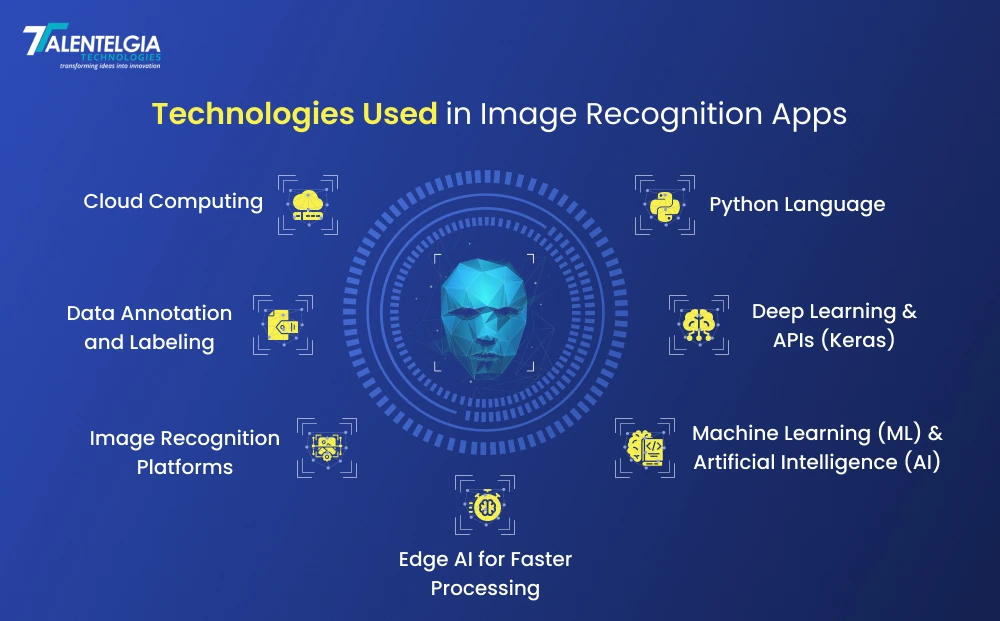
Image recognition applications use powerful technologies that work toward high accuracy and efficient results. The use of advanced technologies has increased the applications of image recognition in daily life.
Further, these applications run visual data in real-time through pattern recognition of objects and then process the identified features. Therefore these solutions involve supporting apps that necessitate components, including different programming languages, machine learning models, AI algorithms, or either cloud or edge computing.
Python Language
This language is very simple and has solid support for machine learning and artificial intelligence. That is why Python has been at the forefront among the different programming languages developed to create image recognition applications.
It also has a lot of libraries and frameworks that make it suitable for developers doing work on the system for image recognition software.
Its libraries like OpenCV, TensorFlow, and PyTorch, make it easier to develop complex computer vision functionalities and deep learning algorithms. This makes image recognition app development possible.
Moreover, Python is easy to read and use. This also makes it easier for programmers to write clean, understandable code, even for complex image-processing tasks. This simplicity reduces development time and allows teams to quickly iterate on features and improvements.
Also Read: Top AI Frameworks & Libraries
Deep Learning and APIs (Keras)
Deep learning enables the image recognition system to identify objects, classify images, and process visual data with accuracy.
When working on image recognition, developers use deep learning models. This gives access to its Convolutional Neural Networks (CNNs) which automatically extract and learn features from images without human intervention.
Keras is among the widely used deep-learning APIs in the market for image recognition software, built atop TensorFlow. It provides a smooth interface through which one can create, train, and test models using deep learning. Several layers and architectures are offered for processing images in Keras.
This gives the developers the power to rapidly build applications that would support AI-driven detection, classification, and much more.
Machine Learning (ML) and Artificial Intelligence (AI)
Modern applications in image recognition are based on machine learning and AI development. These technologies help the systems automatically learn from the vast datasets available, recognize images with patterns, and improve continuously. Tasks that depend on ML and AI algorithms include object detection, facial recognition, and image classification.
Supervised learning is very popular in machine learning in image recognition software. Here, the algorithm learns to associate visual features with specific categories or labels based on labeled datasets of images.
The synergy of AI and ML has been the driving force behind applications of image recognition apps across industries. These include self-driving vehicles and healthcare diagnostics, making image recognition an essential application in modern technology.
Edge AI for Faster Processing
Edge AI is gaining traction for sophisticated and high-performance image recognition systems. Edge AI can process information locally on smartphones, cameras, or sensors and not send this information to some central cloud server for processing.
This reduces latency and ensures the fast processing of images and data. This is important for applications like security surveillance or augmented reality.
With Edge AI image recognition can be performed completely on the end device. This increases speed and results in a user-friendly experience and minimizes privacy risks.
Cloud Computing
Cloud computing is important for enabling powerful image recognition systems. Most image recognition apps rely on the cloud for high-performance computing and storage.
However, offloading heavy processing tasks to cloud servers means that developers can ensure the app runs efficiently despite limited processing power.
Therefore, cloud computing enables smooth scaling of image recognition apps because developers can scale resources based on demand. This is particularly important for businesses that have to process large datasets or serve a global user base. Moreover, cloud-based services provide flexibility in storing and managing datasets, training machine learning models, and deploying apps without significant on-premise infrastructure.
Also Read: Cloud Computing Role in Edge AI
How Does AI Image Recognition Work?
Image recognition apps comprise neural networks. These complex systems, inspired by the human brain, learn from gigantic datasets of images. The process of iterative learning helps the neural networks learn what features, patterns, and relationships exist within images.
Image recognition apps commonly utilize neural networks and deep learning to interpret and process visual data. Such networks learn to identify patterns in images through extensive datasets of pictures, mimicking the human visual system.
Training with Labeled and Unlabeled Data: In supervised learning, neural networks train on labeled datasets, with each image tagged with specific information (e.g., “dog” or “car”). In unsupervised learning, the system analyzes unlabeled data to uncover patterns and relationships without human intervention.
Feature Extraction and Pattern Recognition: The neural networks break down the images into smaller elements such as shapes, textures, and colors. The system identifies these features to classify and recognize objects or scenes, with accuracy improved over time.
Continuous Improvement through Feedback: Image recognition software continues to learn and improve with iterative learning. The more the application processes, the more the algorithms are adapted to the feedback received. This helps in improving the accuracy of the predictions and recognitions.
Real-Time Processing and Edge Computing: Some image recognition apps use edge computing, processing images directly on the device (such as a smartphone) for faster, real-time recognition. This eliminates the need for constant cloud communication, enhancing both performance and privacy.
Applications of Image Recognition Apps in Real World
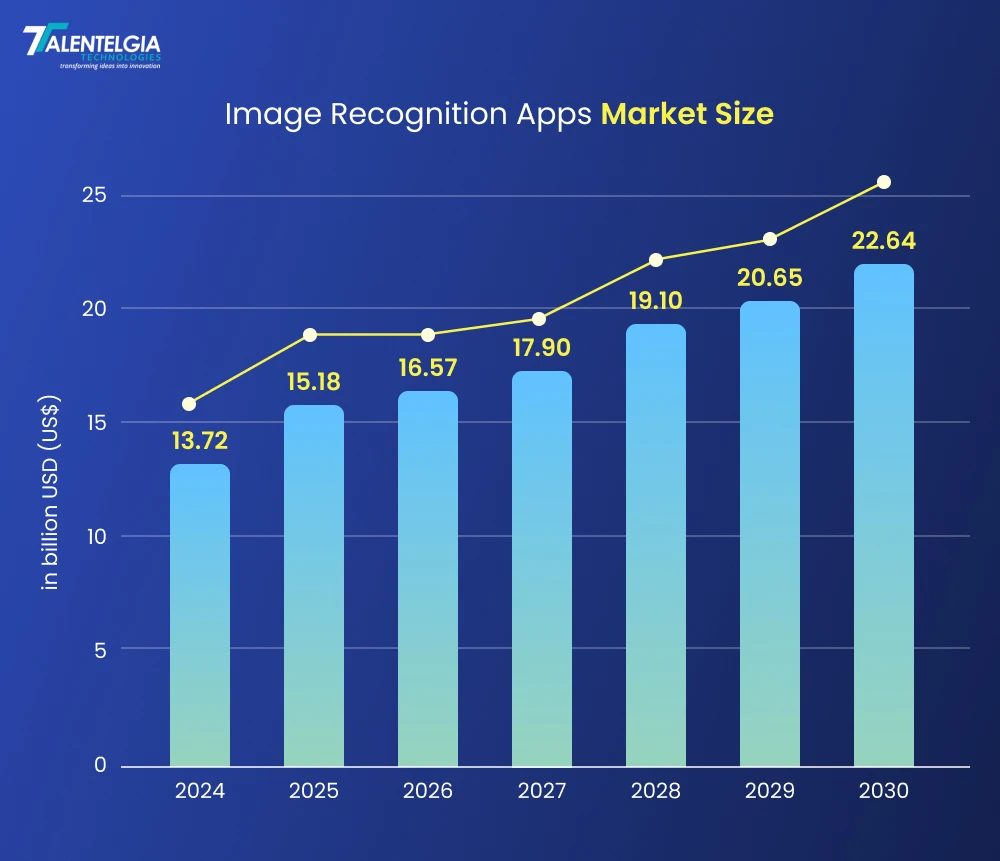
The impact of image recognition apps goes far beyond mere entertainment. They are changing many aspects of our everyday lives, quietly revolutionizing:
These applications have gained popularity in a short period and transformed how we interact with technology. This is done by leveraging machine learning algorithms and the use of more powerful neural networks that can progressively interpret visual data. Here are some of the most transformative areas where image recognition apps are making an undeniable impact.
Visual Search
Gone are the days when you would type in specific keywords or descriptions to search for an object. Visual search apps have made it easier to find products, information, and even wildlife by simply uploading an image.
Visual search apps help link the real and virtual worlds. You might want to find something like what you see in a store or try to recognize some unknown plant or animal. In a visual search app, a user uploads photos of an object. The app then brings similar items found online, offers reviews, compares prices, and allows direct access for purchase.
Social Media
Social media depends on image recognition technology to enhance user experience and, in some cases, value to the customers and business operations.
Facebook and Instagram, for example, use image recognition software to automatically tag people in photographs. This makes sure that users do not go out of their way to find specific friends’ identities. They derive relevant hashtags from visual content and display them in an image. This automatically increases the discoverability and engagement of uploaded images.
The other element of image recognition is used to analyze facial expressions. It helps platforms gauge user sentiment based on photos and videos. This information can then be communicated to algorithms that recommend content for users based on their preferences. For marketers, this technology provides actionable data about user engagement. So they can easily optimize campaigns, target specific audiences, and improve ad targeting based on visual content consumption.
Moreover, image recognition online also moderates content, automatically flagging offensive or inappropriate imagery, hence creating safer, more controlled online spaces.
Security and Surveillance
Image recognition apps play an important role in security and surveillance. Facial recognition systems, for instance, are installed in airports and office buildings, and even smartphones use them to identify people.
Security cameras with image recognition algorithms can scan crowds or specific areas in real-time, identifying suspicious behavior or objects, and alerting authorities faster than human operators could. Law enforcers use such systems to track suspects, identify missing individuals, and solve crimes by comparing surveillance footage images with massive databases. Despite the raging debate on issues of privacy associated with these technological innovations, they have proven undeniable in maintaining the order of things in society.
Healthcare
Healthcare sectors have also brought image recognition to transform diagnosing patients’ health status. This would mean analyzing complicated medical images—X-rays, MRIs, or CT scans—in the process. Image recognition apps help detect anomalies in diseases.
They also have the capability of making their presence indispensable in helping to detect earlier than anyone may imagine. This is helpful in cases like cancer and heart conditions to neurological disorders, as AI can locate abnormalities not recognized visually.
Further, such systems can recognize patterns across a huge number of medical images. This increases the efficiency of diagnostic processes and minimizes human error. In addition to diagnostics, image recognition online is useful in surgical planning, where real-time, accurate visual data are available. This technology has the potential to save lives by ensuring timely interventions and effective treatments.
Also Read: AI Use Cases in Healthcare
Accessibility Solutions
Image recognition applications are playing an important role in promoting accessibility for disabled people, mainly the visually impaired. Applications that describe the contents of images to the blind or low-vision are changing the way they interact in the world. They give audio feedback on these applications, enabling rich, descriptive descriptions of the image.
This helps users navigate surroundings and recognize objects up to identifying a picture of a person. For instance, a blind user can point the phone at a food menu, and the application will read out the available food items. Image recognition online technology may also help literate people who often suffer from illiteracy problems by translating print/text contained in pictures to readable digital format.
E-commerce
Image recognition technology has transformed e-commerce. It helps entrepreneurs sell more and is changing the way people shop. Besides visual search, where a user can look for similar products by uploading an image. Therefore these image recognition apps make it
possible for businesses to give their customers a more personalized shopping experience.
For example, apps can recognize what style or size is preferred with the picture of the customer. They can also recognize preferred or sought clothing items with colors and patterns. This facilitates a much more customized and satisfying shopping experience. It’s also used for tracking emerging fashion trends by checking social media images. So the retailers stay in front of the curve and bring their offerings closer to customer wishes.
Furthermore, the virtual try-on technology, powered by image recognition, lets customers know how clothes, accessories, or even makeup would look on them before buying anything. This technology not only enhances the customer experience but also increases conversion rates and reduces returns, benefiting both consumers and retailers alike.
AI Image Recognition Apps Examples
The use of the latest technologies forms the backbone of modern image recognition apps. It enables them to process and analyze visual data with remarkable accuracy and efficiency. The latest technologies are opening up new possibilities in industries ranging from healthcare to security and beyond. Here are some of the popular image recognition apps:
Google Lens
Google Lens versatile app from Google uses AI to identify a wide range of objects, including landmarks, plants, animals, and even text. It can translate languages, provide information about products, and help with homework assignments.
Key Features
- Object identification
- Plant and animal identification
- Text recognition and translation
- Product information and online shopping
- Homework help
- Landmark recognition
- Image search
Lenso.ai
Lenso.ai is an AI reverse image search tool that enables you to search by image and find matches in the categories like people, places, duplicates, similar and related. With keyword and domain filtering options, you can easily refine and narrow your search for more precise results. The platform’s sorting features also help you quickly identify the best possible match for your image. Additionally, if you perform an in-depth search, you can save images to Collections for easy reference.
Key Features
- Advanced Face Search
- Variety of Categories
- Filter and Sorting options
CamFind
CamFind is a visual search app that can identify objects and deliver relevant information. It recognizes brands, landmarks, or products, helping users find similar items online or learn more about what they are seeing.
Key Features
- Visual search for products, brands, and landmarks
- Online shopping integration
- Information retrieval about identified objects
PlantSnap
The PlantSnap app makes use of the name by identifying the plant species. Take any picture of any plant, and the app shows instant information about that plant, from name to family and even more, making it a comprehensive tool for any plant enthusiast or gardener.
Key Features
- Plant identification
- Detailed plant info (name, family, and more)
- Extensive plant database
Microsoft Seeing AI
This is an application with features that aim at visually impaired users, where the app allows features such as scene description, object identification, text reading, and face recognition. The application provides low-vision users with better information about the surroundings and how to move about.
Key Features
- Scene description
- Object identification
- Text reading
- Face recognition
- Audio descriptions
Adobe Scan
The Adobe Scan document scanning app relies on image recognition technology to enhance the quality of documents scanned. The application automatically detects edges, removes shadows, and even converts images into editable PDFs, making digitizing important papers a lot easier.
Key Features:
- Document scanning
- Image enhancement (edge detection, shadow removal)
- PDF Conversion
- Text recognition (OCR)
- Document organization
Challenges and Considerations
The vast possibilities of image recognition apps come with challenges and ethical concerns that must be addressed.
Privacy: Facial recognition technology has several privacy concerns. Collect and use data responsibly to maintain the rights and freedoms of individuals.
Bias and Fairness: Algorithms developed for AI may inherit biases mirroring sources of training. Thus, there is a great need to counter any bias that might arise in image recognition systems to establish just and fair results.
Job replacement: Image recognition technology will replace jobs by taking over various duties in some sectors. For this reason, technological changes will have social and economic effects that will be included.
The above challenges notwithstanding, the future appears bright for image recognition applications. Responsible development and fair consideration of ethical issues must be embraced to unleash the use of this technology for all and create an efficient, innovative, and inclusive future for society.
Future of Image Recognition: A Glimpse Ahead
The future of image recognition apps is truly promising. With the growing advancement of AI technology, further advanced and innovative image recognition applications are what we can expect. Here are some trends that are likely to dominate the industry.
Augmented reality and virtual reality: Image recognition will be at the heart of enhancing AR and VR app development. The real-world environment or apps will include digital information and create interactive, immersive, and engaging content for users.
Autonomous Vehicles: Image recognition plays a huge role for self-driving cars in their attempts to navigate the world that surrounds them. Such analysis of traffic signs, pedestrians, and other vehicles enables such a system to make the right judgments and ensure safe operations.
Smart Homes: Intelligent house assistants can be made possible with image recognition; an intelligent assistant recognizes objects to monitor activity and deliver a customized experience in smart homes.
Environmental Monitoring: The image recognition technology can be used to monitor environmental changes, track wildlife populations, and detect deforestation and other environmental threats.
Conclusion
Image recognition apps are the future. They are already a reality, transforming the way we interact with the world around us. From making our daily routines convenient and easy to achieve significant change in industries such as healthcare or e-commerce, these applications will bring about a major, long-lasting impact on society.
These apps have a lot of potential which can be unlocked for the creation of a future where the digital offers more personalization and convenience to the user. This will create more opportunities both for the users and the businesses.
So if you are also looking for an image recognition app development company your wait is over! Get in touch with us for advanced mobile or web app development services that suit the user's needs.


 Healthcare App Development Services
Healthcare App Development Services
 Real Estate Web Development Services
Real Estate Web Development Services
 E-Commerce App Development Services
E-Commerce App Development Services E-Commerce Web Development Services
E-Commerce Web Development Services Blockchain E-commerce Development Company
Blockchain E-commerce Development Company
 Fintech App Development Services
Fintech App Development Services Fintech Web Development
Fintech Web Development Blockchain Fintech Development Company
Blockchain Fintech Development Company
 E-Learning App Development Services
E-Learning App Development Services
 Restaurant App Development Company
Restaurant App Development Company
 Mobile Game Development Company
Mobile Game Development Company
 Travel App Development Company
Travel App Development Company
 Automotive Web Design
Automotive Web Design
 AI Traffic Management System
AI Traffic Management System
 AI Inventory Management Software
AI Inventory Management Software
 AI Software Development
AI Software Development  AI Development Company
AI Development Company  AI App Development Services
AI App Development Services  ChatGPT integration services
ChatGPT integration services  AI Integration Services
AI Integration Services  Generative AI Development Services
Generative AI Development Services  Natural Language Processing Company
Natural Language Processing Company Machine Learning Development
Machine Learning Development  Machine learning consulting services
Machine learning consulting services  Blockchain Development
Blockchain Development  Blockchain Software Development
Blockchain Software Development  Smart Contract Development Company
Smart Contract Development Company  NFT Marketplace Development Services
NFT Marketplace Development Services  Asset Tokenization Company
Asset Tokenization Company DeFi Wallet Development Company
DeFi Wallet Development Company Mobile App Development
Mobile App Development  IOS App Development
IOS App Development  Android App Development
Android App Development  Cross-Platform App Development
Cross-Platform App Development  Augmented Reality (AR) App Development
Augmented Reality (AR) App Development  Virtual Reality (VR) App Development
Virtual Reality (VR) App Development  Web App Development
Web App Development  SaaS App Development
SaaS App Development Flutter
Flutter  React Native
React Native  Swift (IOS)
Swift (IOS)  Kotlin (Android)
Kotlin (Android)  Mean Stack Development
Mean Stack Development  AngularJS Development
AngularJS Development  MongoDB Development
MongoDB Development  Nodejs Development
Nodejs Development  Database Development
Database Development Ruby on Rails Development
Ruby on Rails Development Expressjs Development
Expressjs Development  Full Stack Development
Full Stack Development  Web Development Services
Web Development Services  Laravel Development
Laravel Development  LAMP Development
LAMP Development  Custom PHP Development
Custom PHP Development  .Net Development
.Net Development  User Experience Design Services
User Experience Design Services  User Interface Design Services
User Interface Design Services  Automated Testing
Automated Testing  Manual Testing
Manual Testing  Digital Marketing Services
Digital Marketing Services 
 Ride-Sharing And Taxi Services
Ride-Sharing And Taxi Services Food Delivery Services
Food Delivery Services Grocery Delivery Services
Grocery Delivery Services Transportation And Logistics
Transportation And Logistics Car Wash App
Car Wash App Home Services App
Home Services App ERP Development Services
ERP Development Services CMS Development Services
CMS Development Services LMS Development
LMS Development CRM Development
CRM Development DevOps Development Services
DevOps Development Services AI Business Solutions
AI Business Solutions AI Cloud Solutions
AI Cloud Solutions AI Chatbot Development
AI Chatbot Development API Development
API Development Blockchain Product Development
Blockchain Product Development Cryptocurrency Wallet Development
Cryptocurrency Wallet Development About Talentelgia
About Talentelgia  Our Team
Our Team  Our Culture
Our Culture 
 Healthcare App Development Services
Healthcare App Development Services Real Estate Web Development Services
Real Estate Web Development Services E-Commerce App Development Services
E-Commerce App Development Services E-Commerce Web Development Services
E-Commerce Web Development Services Blockchain E-commerce
Development Company
Blockchain E-commerce
Development Company Fintech App Development Services
Fintech App Development Services Finance Web Development
Finance Web Development Blockchain Fintech
Development Company
Blockchain Fintech
Development Company E-Learning App Development Services
E-Learning App Development Services Restaurant App Development Company
Restaurant App Development Company Mobile Game Development Company
Mobile Game Development Company Travel App Development Company
Travel App Development Company Automotive Web Design
Automotive Web Design AI Traffic Management System
AI Traffic Management System AI Inventory Management Software
AI Inventory Management Software AI Software Development
AI Software Development AI Development Company
AI Development Company ChatGPT integration services
ChatGPT integration services AI Integration Services
AI Integration Services Machine Learning Development
Machine Learning Development Machine learning consulting services
Machine learning consulting services Blockchain Development
Blockchain Development Blockchain Software Development
Blockchain Software Development Smart contract development company
Smart contract development company NFT marketplace development services
NFT marketplace development services IOS App Development
IOS App Development Android App Development
Android App Development Cross-Platform App Development
Cross-Platform App Development Augmented Reality (AR) App
Development
Augmented Reality (AR) App
Development Virtual Reality (VR) App Development
Virtual Reality (VR) App Development Web App Development
Web App Development Flutter
Flutter React
Native
React
Native Swift
(IOS)
Swift
(IOS) Kotlin (Android)
Kotlin (Android) MEAN Stack Development
MEAN Stack Development AngularJS Development
AngularJS Development MongoDB Development
MongoDB Development Nodejs Development
Nodejs Development Database development services
Database development services Ruby on Rails Development services
Ruby on Rails Development services Expressjs Development
Expressjs Development Full Stack Development
Full Stack Development Web Development Services
Web Development Services Laravel Development
Laravel Development LAMP
Development
LAMP
Development Custom PHP Development
Custom PHP Development User Experience Design Services
User Experience Design Services User Interface Design Services
User Interface Design Services Automated Testing
Automated Testing Manual
Testing
Manual
Testing About Talentelgia
About Talentelgia Our Team
Our Team Our Culture
Our Culture
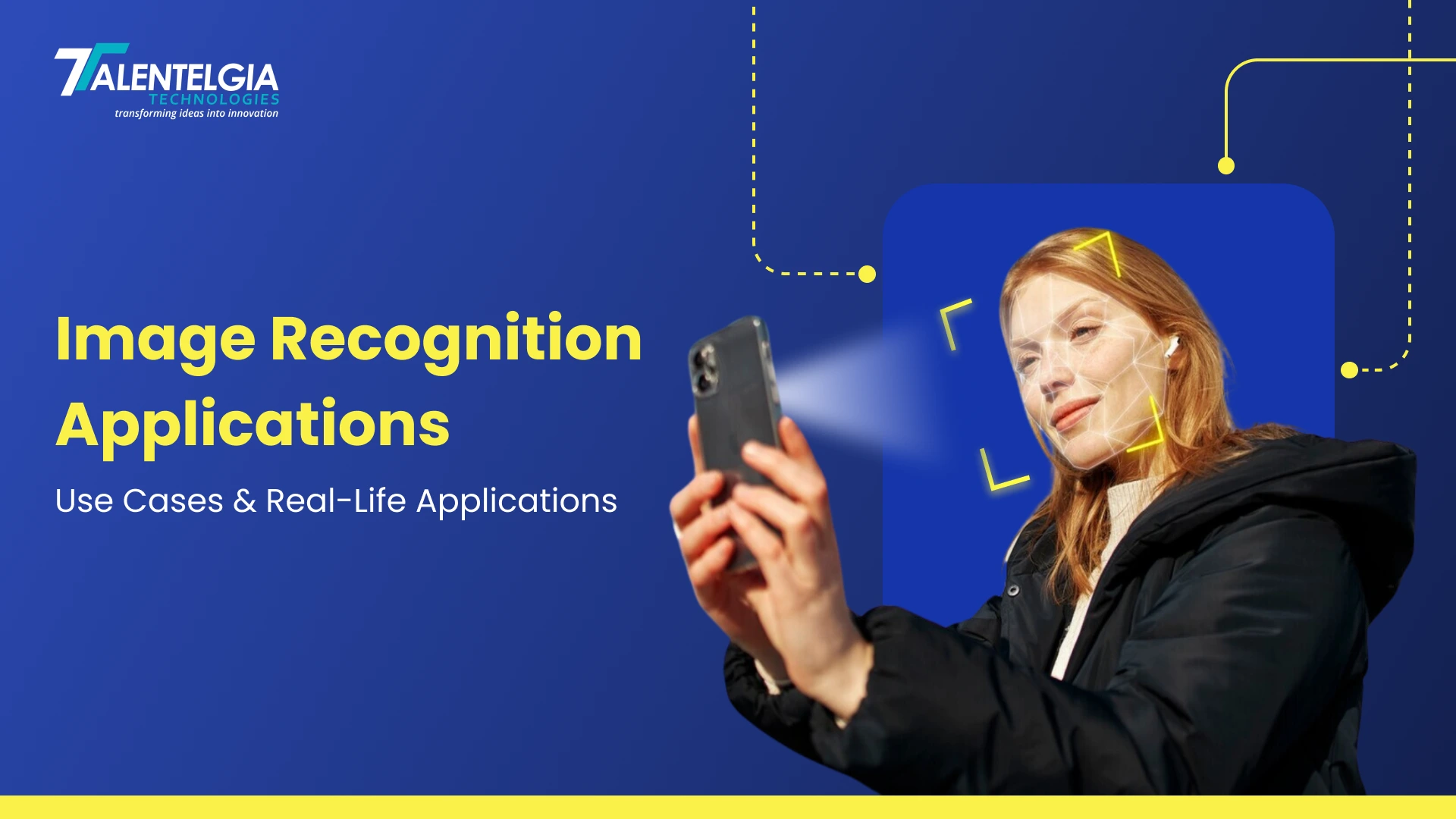

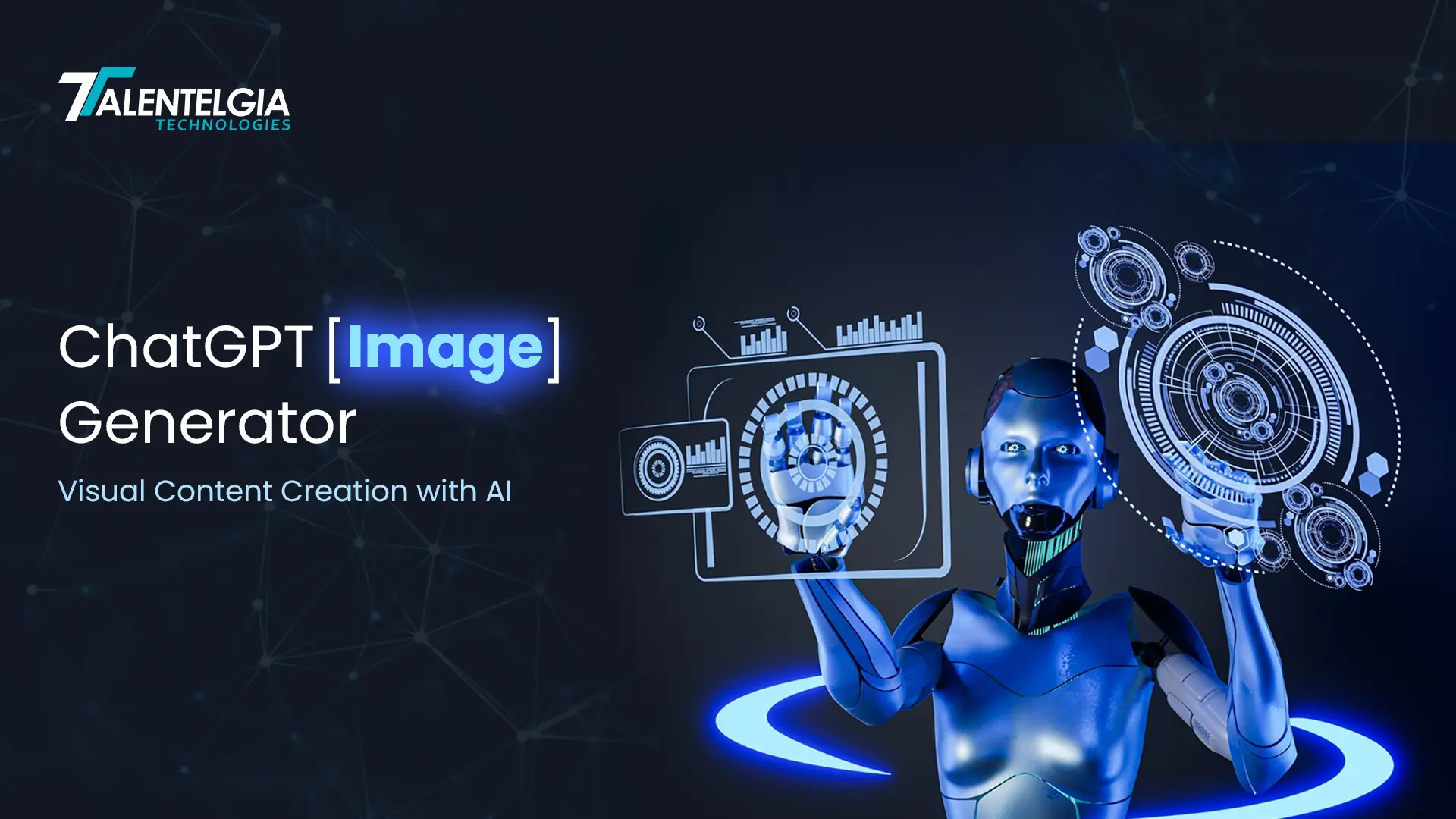

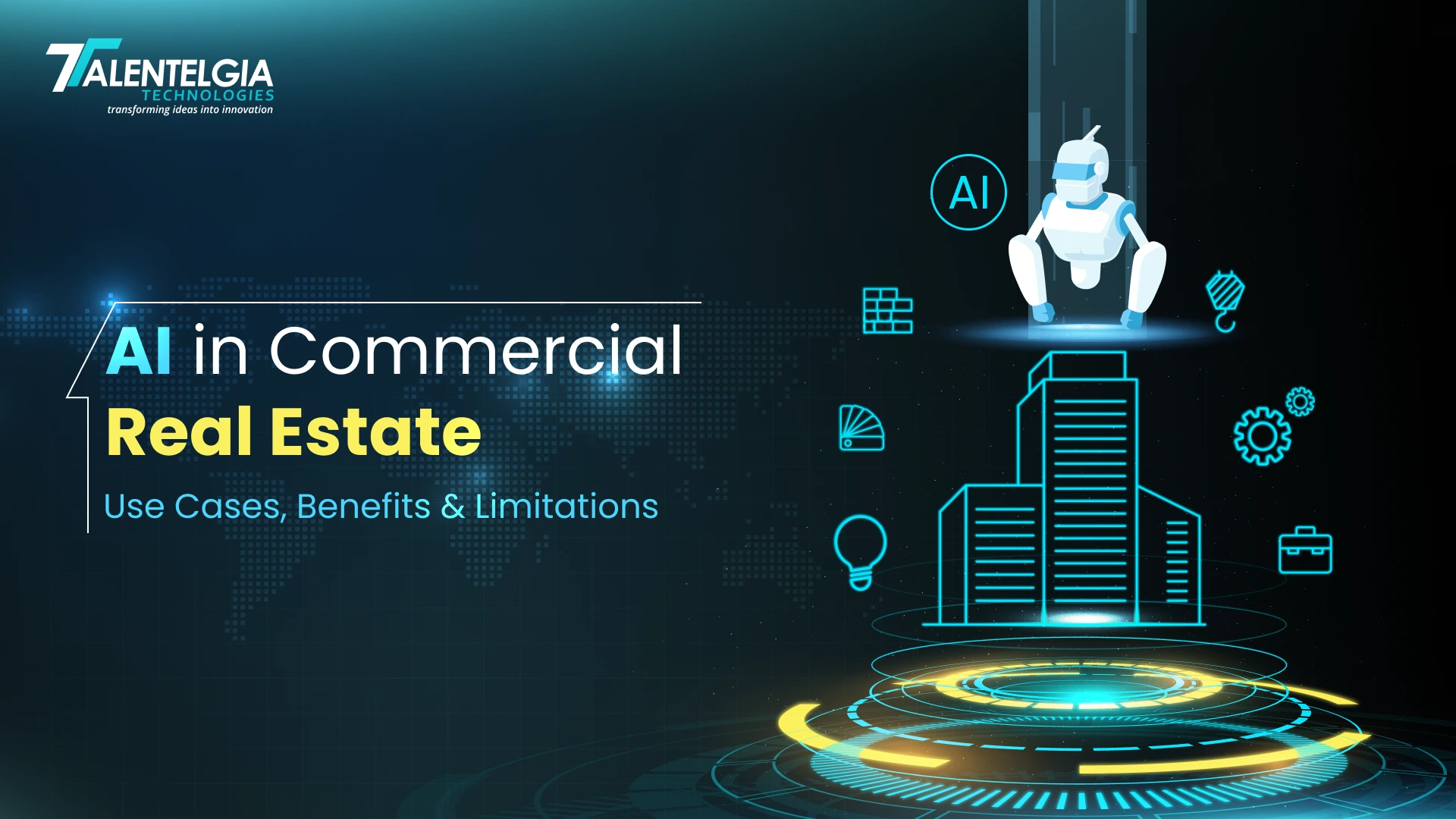
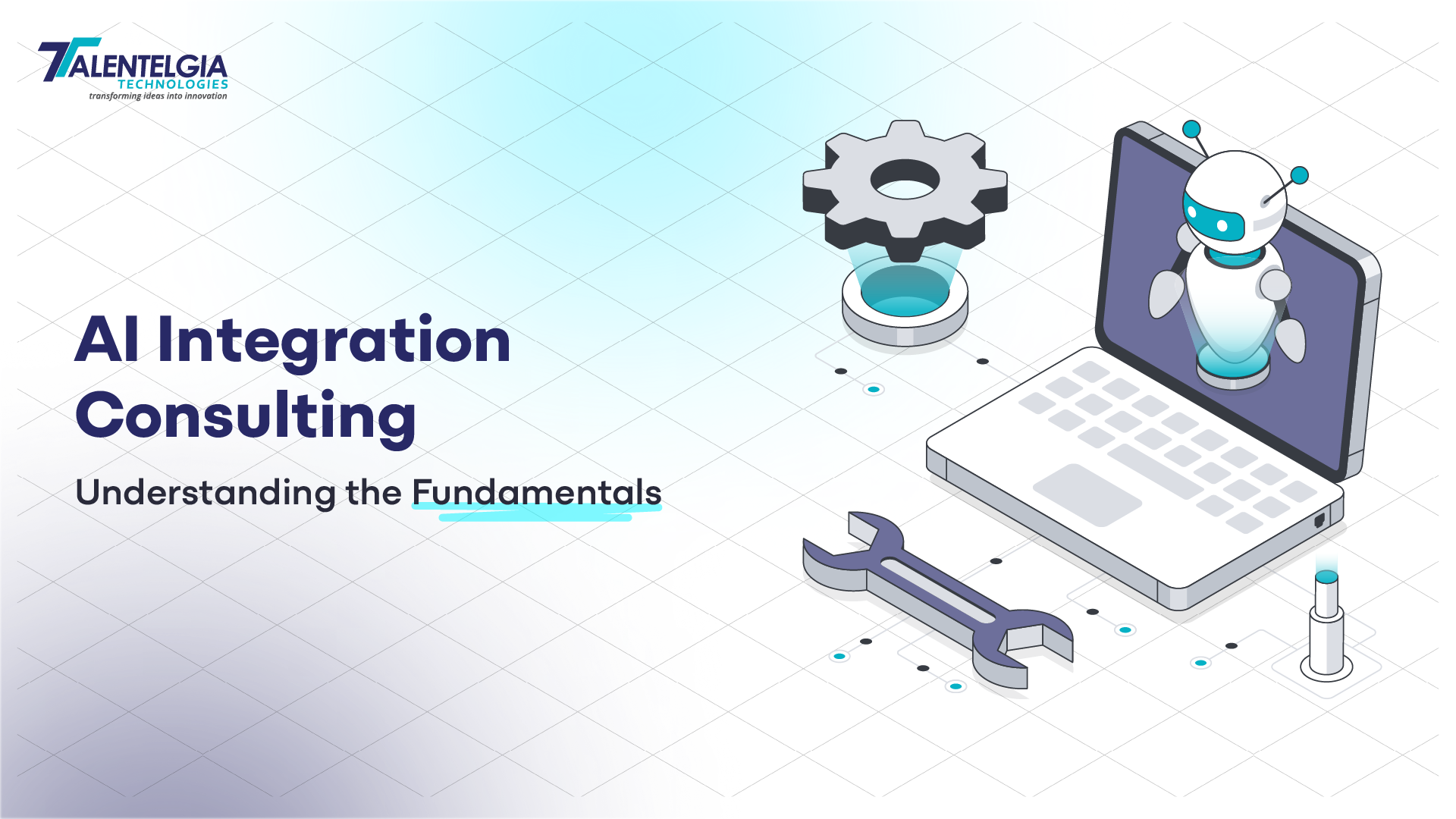











 Write us on:
Write us on:  Business queries:
Business queries:  HR:
HR: 




